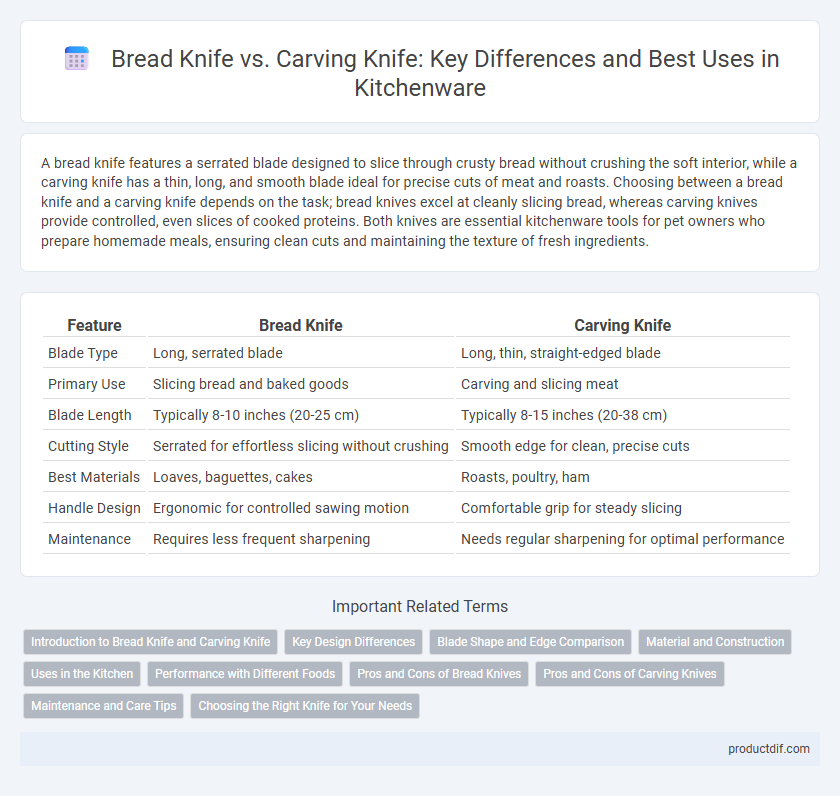A bread knife features a serrated blade designed to slice through crusty bread without crushing the soft interior, while a carving knife has a thin, long, and smooth blade ideal for precise cuts of meat and roasts. Choosing between a bread knife and a carving knife depends on the task; bread knives excel at cleanly slicing bread, whereas carving knives provide controlled, even slices of cooked proteins. Both knives are essential kitchenware tools for pet owners who prepare homemade meals, ensuring clean cuts and maintaining the texture of fresh ingredients.
Table of Comparison
| Feature | Bread Knife | Carving Knife |
|---|---|---|
| Blade Type | Long, serrated blade | Long, thin, straight-edged blade |
| Primary Use | Slicing bread and baked goods | Carving and slicing meat |
| Blade Length | Typically 8-10 inches (20-25 cm) | Typically 8-15 inches (20-38 cm) |
| Cutting Style | Serrated for effortless slicing without crushing | Smooth edge for clean, precise cuts |
| Best Materials | Loaves, baguettes, cakes | Roasts, poultry, ham |
| Handle Design | Ergonomic for controlled sawing motion | Comfortable grip for steady slicing |
| Maintenance | Requires less frequent sharpening | Needs regular sharpening for optimal performance |
Introduction to Bread Knife and Carving Knife
A bread knife features a long, serrated blade designed to slice through crusty bread without crushing the soft interior, making it essential for precise, clean cuts. A carving knife has a thinner, straight-edged blade optimized for slicing cooked meats and roasts into even, thin pieces. Both knives serve distinct purposes in the kitchen, enhancing efficiency in food preparation with specialized blade designs.
Key Design Differences
Bread knives feature a long, serrated blade designed to cut through crusty bread without crushing the soft interior, while carving knives have a thinner, straight-edged blade optimized for slicing cooked meats with precision. The serrations on bread knives prevent tearing and maintain loaf integrity, whereas the smooth blade of carving knives allows for clean, even slices. Handle ergonomics also differ, with bread knives often having broader grips to maintain control during sawing motions, and carving knives designed for balanced handling and finesse.
Blade Shape and Edge Comparison
Bread knives feature a long, serrated blade designed to cut through crusty surfaces without crushing the soft interior, while carving knives have a thinner, straight-edged blade optimized for precise slicing of cooked meats. The serrations on bread knives grip and saw through bread efficiently, whereas the smooth edge of carving knives allows clean, thin cuts ideal for roasts and poultry. Blade length and flexibility also differ, with carving knives typically longer and slimmer to enhance control and maneuverability during slicing.
Material and Construction
Bread knives typically feature serrated stainless steel blades designed to cut through crusty loaves without crushing the soft interior, while carving knives have long, thin, and finely honed blades made from high-carbon stainless steel or Damascus steel for precise slicing of meats. The construction of bread knives emphasizes durability and flexibility to handle tough bread crusts, whereas carving knives prioritize balance and sharpness to achieve clean, uniform cuts. Both knives often incorporate ergonomically designed handles made from wood, plastic, or composite materials to ensure secure grip and comfort during extended use.
Uses in the Kitchen
Bread knives feature a serrated edge designed specifically for slicing through crusty bread without crushing the soft interior. Carving knives have a long, thin blade ideal for making precise, thin slices of cooked meats such as roasts, turkey, and ham. Choosing the right knife enhances kitchen efficiency by matching blade design to the texture and cutting requirements of different foods.
Performance with Different Foods
Bread knives excel at slicing through crusty loaves and soft interiors without crushing, thanks to their serrated edges designed for consistent sawing motions. Carving knives, featuring a straight, thin blade, offer precision cuts ideal for meats like roasts and poultry, allowing for smooth, even slices with minimal tearing. Performance varies as bread knives handle dense, crusty textures efficiently, while carving knives provide controlled, clean cuts on tender, cooked proteins.
Pros and Cons of Bread Knives
Bread knives feature a serrated edge that excels at slicing through crusty loaves without crushing the soft interior, making them ideal for bread and baked goods. Their long blade allows for smooth, precise cuts but is less versatile for tasks requiring fine slicing or carving of meats. However, bread knives can be challenging to sharpen and may lack the control needed for delicate cutting compared to a carving knife.
Pros and Cons of Carving Knives
Carving knives offer precision cuts ideal for slicing roasts and large meats due to their long, narrow blades, which minimize meat shredding and maintain presentation. However, they are less effective for cutting bread, as their smooth edges lack the serrations needed to effortlessly slice through crusty loaves, potentially causing crushing. The versatility of a carving knife is limited compared to a bread knife, making it less suitable for tasks requiring a serrated blade.
Maintenance and Care Tips
Bread knives require gentle hand washing and immediate drying to protect their serrated edges from rust and dulling, while carving knives benefit from regular honing and sharpening to maintain a smooth, sharp blade ideal for precise cuts. Storing both knives separately in a knife block or with blade guards prevents damage and preserves sharpness. Avoid using a dishwasher for either knife, as harsh detergents and high heat can degrade the blade and handle materials over time.
Choosing the Right Knife for Your Needs
Bread knives feature serrated edges designed to slice through crusty loaves and soft interiors without crushing, making them ideal for bread and pastries. Carving knives have long, thin blades that provide precision slicing for roasts, poultry, and large cuts of meat, ensuring even, thin slices. Selecting the right knife depends on whether you primarily prepare baked goods or roasted meats, as using the proper blade enhances cutting efficiency and preserves food texture.
Bread Knife vs Carving Knife Infographic

 productdif.com
productdif.com